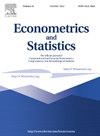Flexible and Robust Particle Tempering for State Space Models
IF 2
Q2 ECONOMICS
引用次数: 0
Abstract
Density tempering (also called density annealing) is a sequential Monte Carlo approach to Bayesian inference for general state models which is an alternative to Markov chain Monte Carlo. When applied to state space models, it moves a collection of parameters and latent states (which are called particles) through a number of stages, with each stage having its own target distribution. The particles are initially generated from a distribution that is easy to sample from, e.g. the prior; the target at the final stage is the posterior distribution. Tempering is usually carried out either in batch mode, involving all the data at each stage, or sequentially with observations added at each stage, which is called data tempering. Efficient Markov moves for generating the parameters and states for each stage of particle based density tempering are proposed. This allows the proposed SMC methods to increase (scale up) the number of parameters and states that can be handled. Most current methods use a pseudo-marginal Markov move step with the states “integrated out”, and the parameters generated by a random walk proposal; although this strategy is general, it can be very inefficient when the states or parameters are high dimensional. By adding batch tempering at each stage, previous methods are extended to make data tempering more robust to outliers and structural changes for models with intractable likelihoods. The performance of the proposed methods is evaluated using univariate stochastic volatility models with outliers and structural breaks, and high dimensional factor stochastic volatility models having many parameters and many latent states.1
状态空间模型的柔性鲁棒粒子回火
密度回火(也称为密度退火)是一种对一般状态模型贝叶斯推理的顺序蒙特卡罗方法,是马尔科夫链蒙特卡罗的替代方法。当应用于状态空间模型时,它通过许多阶段移动参数和潜在状态(称为粒子)的集合,每个阶段都有自己的目标分布。粒子最初是从易于采样的分布中生成的,例如先验;最后阶段的目标是后验分布。回火通常以批处理的方式进行,包括每阶段的所有数据,或者按顺序在每阶段添加观察值,这称为数据回火。提出了粒子密度回火各阶段参数和状态生成的有效马尔可夫算子。这允许提议的SMC方法增加(扩大)可以处理的参数和状态的数量。目前大多数方法采用状态“积分出”的伪边际马尔可夫移动步骤,参数生成采用随机游走方案;尽管这种策略是通用的,但当状态或参数是高维的时候,它可能非常低效。通过在每个阶段添加批量回火,扩展了之前的方法,使数据回火对异常值和具有难处理似然模型的结构变化具有更强的鲁棒性。采用具有异常值和结构断裂的单变量随机波动模型和具有多参数和多潜在状态的高维因子随机波动模型对所提方法的性能进行了评价
本文章由计算机程序翻译,如有差异,请以英文原文为准。
求助全文
约1分钟内获得全文
求助全文
来源期刊

Econometrics and Statistics
ECONOMICS-
CiteScore
3.10
自引率
10.50%
发文量
84
期刊介绍:
Econometrics and Statistics is the official journal of the networks Computational and Financial Econometrics and Computational and Methodological Statistics. It publishes research papers in all aspects of econometrics and statistics and comprises of the two sections Part A: Econometrics and Part B: Statistics.
 求助内容:
求助内容: 应助结果提醒方式:
应助结果提醒方式:


